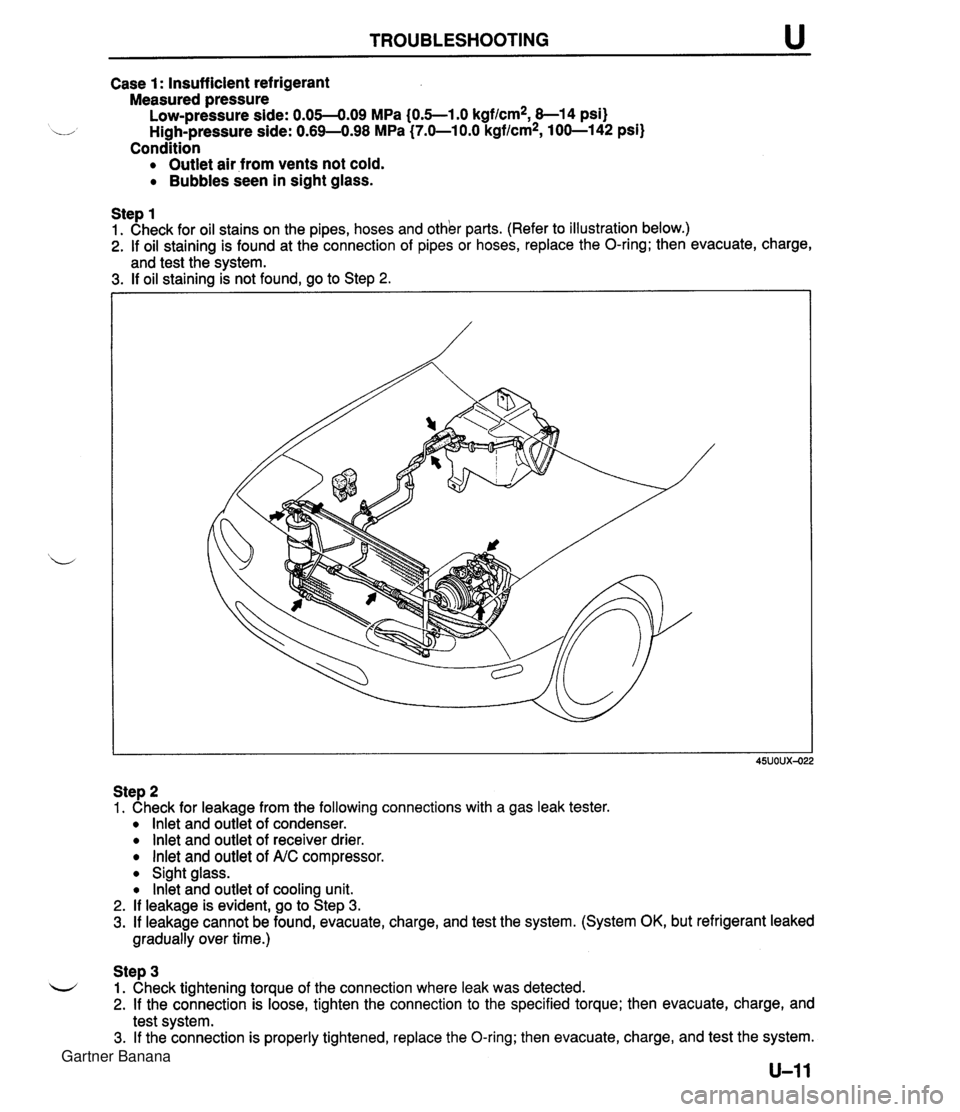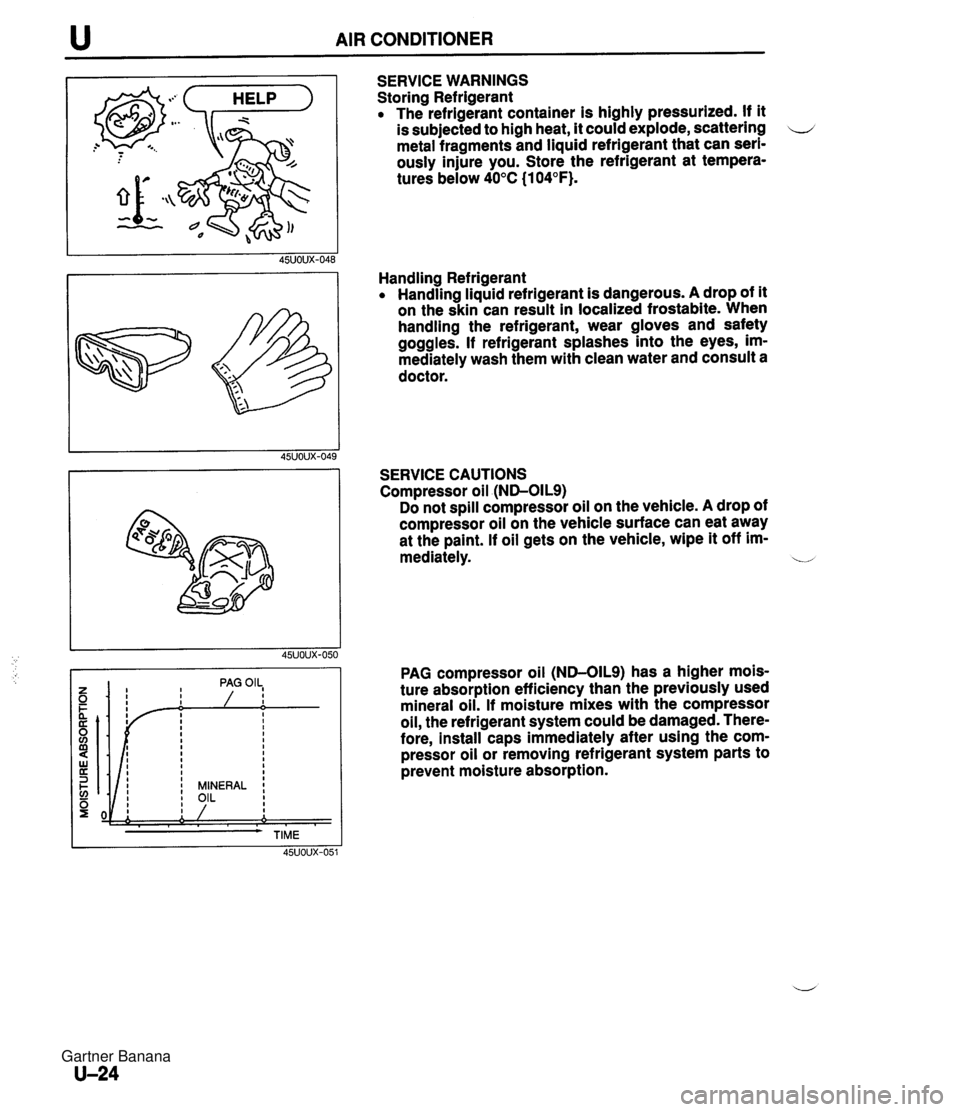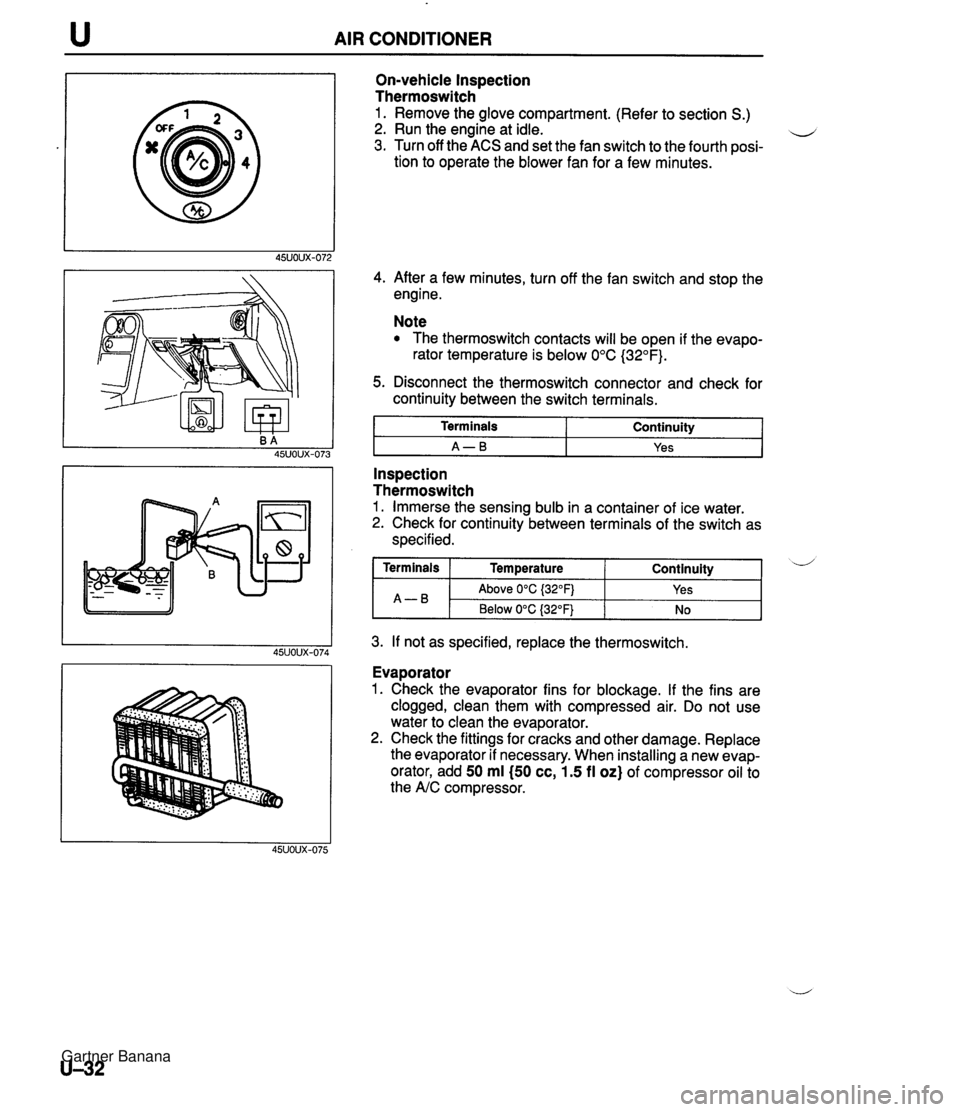Page 878 of 1708
INSTRUMENT CLUSTER T I OIL PRESSURE SENSOR 3. If not as specified, replace the oil pressure sensor. OIL PRESSURE SENSOR lnspection 1. Disconnect the oil pressure sensor connector. 2. Measure resistance between the oil pressure sensor and a body ground as shown. SPEEDOMETER CABLE lnspection 1. Disconnect the speedometer cable from the instrument cluster and transmission case. 2. Verify that the cable and gear spin easily when turned by hand. 3. If the cable or gear is stiff, replace as necessary. Condition Engine stopped Engine running Resistance 110-13052 13- 55R Gartner Banana
Page 1073 of 1708

TROUBLESHOOTING Case 1: Insufficient refrigerant Measured pressure Low-pressure side: 0.05-4.09 MPa (0.5--1.0 kgf/cm2, 8-1 4 psi) u High-pressure side: 0.69-498 MPa (7.0-1 0.0 kgflcm2, 100-142 psi) Condition Outlet air from vents not cold. Bubbles seen in sight glass. Step 1 1. Check for oil stains on the pipes, hoses and other parts. (Refer to illustration below.) 2. If oil staining is found at the connection of pipes or hoses, replace the O-ring; then evacuate, charge, and test the svstem. 3. If oil staining k not found, go to Step 2. Step 2 1. Check for leakage from the following connections with a gas leak tester. lnlet and outlet of condenser. lnlet and outlet of receiver drier. lnlet and outlet of A.C compressor. Sight glass. lnkt and outlet of cooling unit. 2. If leakage is evident, go to Step 3. 3. If leakage cannot be found, evacuate, charge, and test the system. (System OK, but refrigerant leaked gradually over time.) Step 3 L-/ 1. Check tightening torque of the connection where leak was detected. 2. If the connection is loose, tighten the connection to the specified torque; then evacuate, charge, and test system. 3. If the connection is properly tightened, replace the O-ring; then evacuate, charge, and test the system. Gartner Banana
Page 1086 of 1708

u AIR CONDITIONER SERVICE WARNINGS Storing Refrigerant The refrigerant container is highly pressurized. If it is subjected to high heat, it could explode, scattering u metal fragments and liquid refrigerant that can seri- ously injure you. Store the refrigerant at tempera- tures below 40°C (1 04°F). Handling Refrigerant Handling liquid refrigerant is dangerous. A drop of it on the skin can result in localized frostabite. When handling the refrigerant, wear gloves and safety goggles. If refrigerant splashes into the eyes, im- mediately wash them with clean water and consult a doctor. SERVICE CAUTIONS Compressor oil (ND-OILS) Do not spill compressor oil on the vehicle. A drop of compressor oil on the vehicle surface can eat away at the paint. If oil gets on the vehicle, wipe it off im- mediately. b PAG compressor oil (ND-OILS) has a higher mois- ture absorption efficiency than the previously used mineral oil. If moisture mixes with the compressor oil, the refrigerant system could be damaged. There- fore, install caps immediately after using the com- pressor oil or removing refrigerant system parts to prevent moisture absorption. Gartner Banana
Page 1092 of 1708
u AIR CONDITIONER COOLING UNIT Removal 1 Installation 1. Discharge the refrigerant system. 2. Remove the glove compartment. (Refer to section S.) il 3. Remove in the order shown in the figure. Immediately plug all open fittings to keep moisture out of the system. 4. Install in the reverse order of removal. Position the unit so that its connections match those of the heater unit and blower unit. Apply clean compressor oil to the O-rings before connecting the fittings; do not ap- ply compressor oil to the fitting nuts. Tightening torque Inlet pipe: 10-19 N-m (1.0-2.0 kgfsm, 8-14 ft-lbf} Outlet pipe: 20-29 N-m (2.0-3.0 kgf-m, 15--21 ft-lbf} 5. Charge the refrigerant system. (Refer to page U-25.) 7.910.7 N.m {EO-110 kgfmn, 69.5-95.4 In4bf} 45uoux-071 1. Cooling unit 2. Sealing plate Disassembly / Assembly . . . . . . page U-31 U-30 Gartner Banana
Page 1093 of 1708
AIR CONDITIONER u Disassembly 1 Assembly 1. Disassemble in the order shown in the figure. 1. Evaporator 3. Thermoswitch ................... ......... Inspection page U-32 On-vehicle Inspection page U-32 ................... 2. Expansion valve Inspection page U-32 ................... Assembly note below Assembly note Expansion valve Apply clean compressor oil to the O-rings before con- necting the fittings; do not apply compressor oil to the fit- ting nuts. Gartner Banana
Page 1094 of 1708

AIR CONDITIONER On-vehicle Inspection Thermoswitch 1. Remove the glove compartment. (Refer to section S.) 2. Run the engine at idle. u 3. Turn off the ACS and set the fan switch to the fourth posi- tion to operate the blower fan for a few minutes. 4. After a few minutes, turn off the fan switch and stop the engine. Note The thermoswitch contacts will be open if the evapo- rator temperature is below 0°C (32°F). 5. Disconnect the thermoswitch connector and check for continuity between the switch terminals. I Terminals I Continuity I I A-B I Yes I - -- Inspection Thermoswitch 1. Immerse the sensing bulb in a container of ice water. 2. Check for continuity between terminals of the switch as specified. 3. If not as specified, replace the thermoswitch. Continuity ( Terminals I Temperature A-B Evaporator 1. Check the evaporator fins for blockage. If the fins are clogged, clean them with compressed air. Do not use water to clean the evaporator. 2. Check the fittings for cracks and other damage. Replace the evaporator if necessary. When installing a new evap- orator, add 50 ml (50 cc, 1.5 fl oz) of compressor oil to the A/C compressor. d Above 0°C {32OFj Below 0°C (32°F) Yes No Gartner Banana
Page 1095 of 1708
AIR CONDITIONER u CONDENSER AND RECEIVER DRIER Removal 1 Installation 1. Raise the front of the vehicle at least 300 mm (11.8 in) and support it on safety stands. 2. Discharge the refrigerant system. 3. Remove the splash shield and air guide. 4. Remove in the order shown in the figure. Immediately plug any open fittings to keep moisture out of the system. 5. Install in the reverse order of removal. Apply clean compressor oil to the O-rings before connecting the - fittings; do not apply compressor oil to the fitting nuts. Tightening torque Receiver drier inlet and outlet: 10-19 N-m (1.0-2.0 kgf-m, 8-14 ft-lbf) Condenser inlet: 15-24 N.m (1.5-2.5 kgfsm, 11-18 ft-lbf} 6. Install the air guide and splash shield. 7. Charge the refrigerant system. (Refer to page U-25.) 1. Condenser 2. Receiver drier On-vehicle Inspection . . . . . . . . . page U-34 On-vehicle Inspection . . . . . . . . . page U-34 U-33 Gartner Banana
Page 1096 of 1708
u AIR CONDITIONER On-vehicle Inspection Condenser 1. Check for oil stains on the condenser or fittings. 2. If staining is found at a fitting, replace the O-ring at the u fitting. 3. Charge the system and check for leaks. 4. If leakage is found at a fitting or the condenser, replace parts as necessary. 5. Check the condenser for the following: (1) Cracks or damage (2) Bent fins (3) Distorted or damaged condenser inlet or outlet 6. Repair or replace as necessary. If the condenser is re- placed, add 30 ml(30 cc, 0.9 fi oz} of compressor oil. Receiver drier 1. Check for oil stains on the fittings. 2. If staining is found, replace the O-ring at the fitting. 3. Charge the system and check for leaks. 4. If leakage is found, replace the receiver drier or piping. When replacing the receiver drier, add 10 ml I10 cc, 0.3 -, fl or) of compressor oil. Gartner Banana